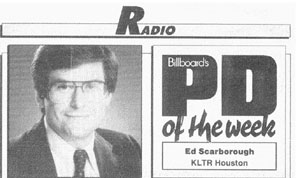|
|
"K-LITE IS THE ONLY station in the history of CBS to repair
itself without a format change," says AC KLTR Houston PD Ed Scarborough, discussing
his station's turnaround since 1986, a rebound that took place with few staff changes. |
"We have to watch our musical range. We don't want to play anything so maudlin or deadly slow that it [under - mines] the benefits of listening to K-Lite. We watch the tempo of a song and ask ourselves if it fits the environ - ment of our radio station. Does it stand out in any way and, if so, is it in a positive or a negative way?" Two songs KLTR rejected, for example, were Gloria Estefan's "Get On Your Feet" (too uptempo) and Roxette's "Listen To Your Heart" ( "because of that heavy fuzz guitar" says Scarborough ). About 30% of the music heard on K-Lite is from the '80's, 50% is '70's material, and the remaining 20% is pre-1970. |
 |
|
| A recent p.m. drive stretch of KLTR included: Medley
& Warnes, "Time Of My Life"; Firefall,
"Just Remember I Love You"; Rick Astley, "Never Gonna Give You Up; " the Temptations, "(Ain't) Too Proud To Beg," Linda Ronstadt, "When Will I Be Loved"; Percy Sledge, "When A Man Loves A Woman"; Naked Eyes, "Promises Promises;" Air Supply, "Lost In Love;" Stevie Wonder, "I Just Called To Say I Love You;" the Beatles, "Michelle;" and Expose, "When I Looked At Him." KLTR's marketing efforts have centered around its Frequent Listener Club, one of the earliest such promotions. Club members are contacted by mail on a regular basis and are the only ones eligible to win station contests. "There are no losers in our contests," says Scarborough. "If a club member doesn't call within an allotted time, we'll send them two concert tickets anyway." Scarborough says the club, which now boasts 35,000 members; has been "a marvelous marketing tool." FLC promotions, according to Scarborough, are good for an automatic increase in TSL; cume is built by other means, including TV and mailouts to non-members. At present, KLTR does not really have a direct competitor: "Classic Hits" KFMK plays few currents; KQUE plays an odd mix of AC and adult standards; and easy listening KODA "has modified its music somewhat and is now stepping on our turf. "I realize that right now we're on top of the game, and a lot of people are responsible for that," he says. That includes our GM Miles Sexton, who has been "a guiding force in the marketing of this radio station," the "brass" at CBS in New York who have given "tremendous moral and financial support as well as the patience to let us turn this thing around," and KLTR's air staff. "I'm a realist regarding K-Lite and its future growth," says Scarborough. "My personal goal for the station is just to defend our turf. The challenges will constantly be coming at us. Good PD's are the ones who maintain the numbers, not necessarily those who achieve them. " PHYLLIS STARK |
|
